The April 2015 S&P Case Shiller home price index shows a seasonally adjusted 4.9% price increase from a year ago for the 20 metropolitan housing markets and a 4.6% yearly price increase in the top 10 housing markets. Congratulations America, once again homes are not affordable. There is a slowdown in the overall rate of the increases, yet home prices are climbing over double the rate of inflation, triple if one takes recent annual inflation figures. There are now no city areas where home prices have declined annually. Since March 2012, the 10-City composite index has increased 31% and the 20-City composite index has increased 32%. From the housing bubble 2006 peaks, prices are now only down about 14-16%.
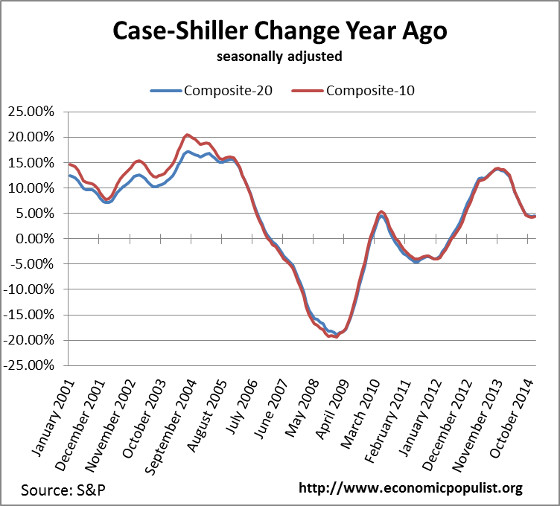
Below are all of the composite-20 index cities yearly price percentage change, using the seasonally adjusted data. San Francisco home prices increased 9.9% from a year ago and Denver Colorado increased by 10.3%. Silicon valley is clearly not affordable even for people making six figures. The west prices are higher than in other parts of the country, yet we can see increases everywhere way above the rate of inflation. Clearly prices are not affordable as they return to housing bubble levels.
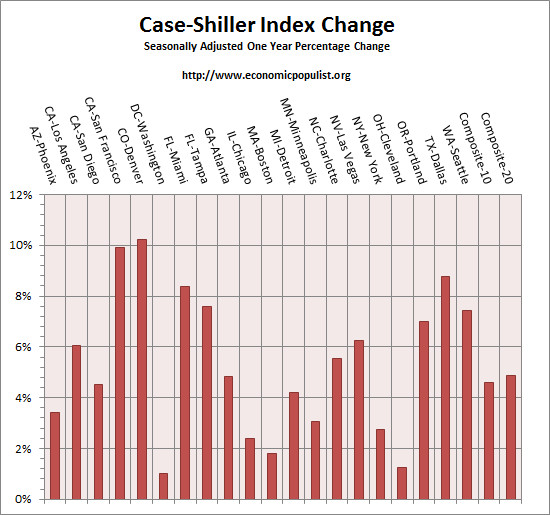
S&P reports the not seasonally adjusted data for their headlines. Housing is highly cyclical. Spring and early Summer are when most sales occur. For the month, the not seasonally adjusted composite-20 percentage change was 1.1% whereas the seasonally adjusted change for the composite-20 was 0.3%. The not seasonally adjusted composite-10 saw a 1.0% increased from last month, whereas the seasonally adjusted composite-10 showed a 0.4% increase. Spring is when the not seasonally adjusted should be around the seasonally adjusted monthly values. The below graph shows the seasonally adjusted monthly percentage change. We think this is much more valid and notice the (finally), a few monthly declines in prices when using the seasonally adjusted housing data.
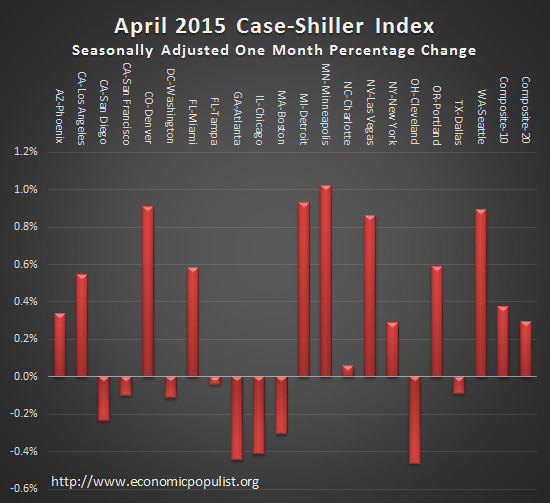
Prices are normalized to the year 2000. The index value of 150 means single family housing prices have appreciated, or increased 50% since 2000 in that particular region. Case-Shiller indices are not adjusted for inflation. Below are the seasonally adjusted levels for the month.
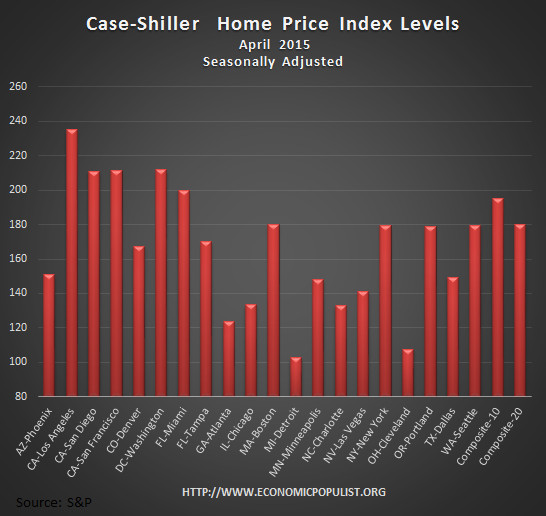
S&P publishes a national index for home prices which has increased 4.2% for the year. S&P also comments on home prices versus inflation Below is a quote from S&P:
The real, or inflation adjusted, price change since 1975 is one percent per year. Given the current inflation rate of under two percent, real home prices today are rising more quickly than is typical.
They also noted that apartments are 34% of housing starts when historically rentals have been 22%. In other words, good old fashioned supply and demand maybe behind the increasing prices. Yet with wages flat, it is a wonder who is buying these homes as they are assuredly not affordable by the average or median wage. Bottom line home prices are not affordable in most cities, or at least in California land. There are many other housing indicators showing this is the case.
To Season or Not to Season, That is the Question:
The S&P/Case-Shiller Home Price Indices are calculated monthly using a three-month moving average and published with a two month lag. Their seasonal adjustment calculation is the standard used for all seasonal adjustments, the X-12 ARIMA, maintained by the Census. The headlines and Case-Shiler's report uses the not seasonally adjusted data. Not seasonally adjusted data can create more headline buzz on a month by month basis due to the seasonality of the housing market. S&P does make it clear that data should be compared to a year ago, to remove seasonal patterns, yet claims monthly percentage changes should use not seasonally adjusted indices and data. This seems more invalid than dealing with the statistical anomalies the massive housing bubble burst caused. Below is the seasonally adjusted and not seasonally adjusted Composite-20 Case-Shiller monthly index, for comparison's sake.
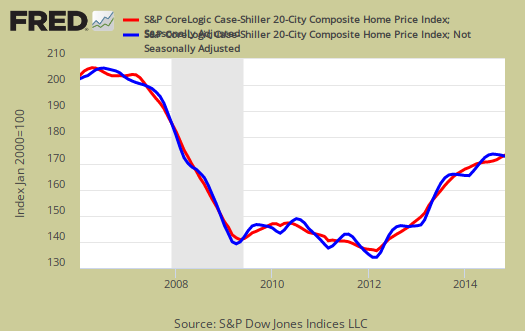
For more Information:
S&P does a great job of making the Case-Shiller data and details available for further information and analysis on their website.
Here is our Case-Shiller past overviews as well as the overviews of residential real estate statistics.

Recent comments